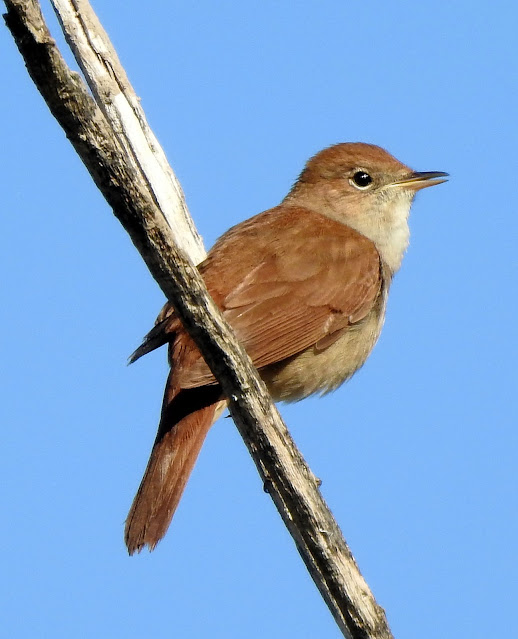This Blog contains Wildlife and Bird Photos from Walks, Safaris, Birding Trips and Vacations. Most of the pictures have been taken with my Nikon P900 and P950X cameras. On the right of the page are labels for each species of Bird/Animal etc. Click on a label to show all of the photos taken for that species. Information for each species is from Wikipedia. Just click on any image for a large picture.
TOTAL PAGEVIEWS
TRANSLATE
Friday, 4 June 2021
Thursday, 3 June 2021
25-5-2021 TABLAS DE DAIMIEL, LA MANCHA - COMMON NIGHTINGALE (Luscinia megarhynchos)
It is a migratory insectivorous species breeding in forest and scrub in Europe and the Palearctic, and wintering in Sub-Saharan Africa. It is not found naturally in the Americas. The distribution is more southerly than the very closely related thrush nightingale Luscinia luscinia. It nests on or near the ground in dense vegetation. Research in Germany found that favoured breeding habitat of nightingales was defined by a number of geographical factors.
less than 400 m (1,300 ft) above mean sea level
mean air temperature during the growing season above 14 °C (57 °F)
more than 20 days/year on which temperatures exceed 25 °C (77 °F)
annual precipitation less than 750 millimetres (30 in)
aridity index lower than 0.35
no closed canopy
In the U.K., the bird is at the northern limit of its range which has contracted in recent years, placing it on the red list for conservation. Despite local efforts to safeguard its favoured coppice and scrub habitat, numbers fell by 53 percent between 1995 and 2008. A survey conducted by the British Trust for Ornithology in 2012 and 2013 recorded some 3,300 territories, with most of these clustered in a few counties in the southeast of England, notably Kent, Essex, Suffolk, and East and West Sussex.
By contrast, the European breeding population is estimated at between 3.2 and 7 million pairs, giving it green conservation status (least concern.
Wednesday, 2 June 2021
25-5-2021 TABLAS DE DAIMIEL, LA MANCHA - COMMON NIGHTINGALE (Luscinia megarhynchos)
Its song is particularly noticeable at night because few other birds are singing. This is why its name includes "night" in several languages. Only unpaired males sing regularly at night, and nocturnal song probably serves to attract a mate. Singing at dawn, during the hour before sunrise, is assumed to be important in defending the bird's territory. Nightingales sing even more loudly in urban or near-urban environments, in order to overcome the background noise. The most characteristic feature of the song is a loud whistling crescendo that is absent from the song of its close relative, the thrush nightingale (Luscinia luscinia). It has a frog-like alarm call.
The bird is a host of the acanthocephalan intestinal parasite Apororhynchus silesiacus.
Subscribe to:
Posts (Atom)

















































